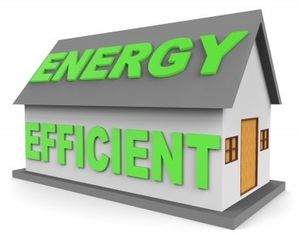
Image courtesy Stuart MilesFreeDigitalPhotos.net
Did you know that if you maximize the energy efficiency of your home, that you can can actually cut annual utility bills in half? Let´s start by breaking down what you´re actually paying to the power company every month. If we take as a starting point the national averages from the U.S. Department of Energy, nearly half – 44 percent – of your power bill is from energy usage in heating and cooling your home. Thirty-three percent goes to lighting, cooking and other appliances, 14 percent from the water heater, and 9 percent is energy used by the refrigerator alone. Home buyers are increasingly aware of these costs.
Ensure your thermostat is properly installed and programmed
One of the best ways to make your home more energy efficient has to do with your home’s thermostat. Assuring that your home’s thermostat is properly programmed is essential in saving big on electricity costs. Many people overlook the impact of their home’s thermostat and leave it on all throughout the day, whether they are home or at work. By programming your thermostat to run only during the times when you are home, you will keep your home warm and see a big improvement in cost savings. Always remember to turn your home’s thermostat down when you are not at home. Your bank account – and your significant other – will thank you once you´ve saved that money!
Seal in the good stuff – Keep out the bad – INSULATE
Do you have enough insulation in your home? Is it properly installed? Insulation is a key component in making sure your home is energy efficient. Why? Insulation keeps your home warm during the winter, and keeps it cool in the summer. Having an insulated home is a great investment that will save you big in the long run.
Take advantage of natural light
Take full advantage of your home´s windows by allowing the sun into your home during the day. Not only is it aesthetically pleasing – sunlight is free! Utilizing natural light can lead to substantial energy savings. Electric lighting in buildings consumes more than 15 percent of all electricity generated in the United States, according to the U.S. Department of Energy and the U.S. Energy Information Administration. Spaces outfitted with daylight-sensing controls can reduce the energy used for electric lighting by 20 percent to 60 percent, according to the studies “Photoelectric Control: The Effectiveness of Techniques to Reduce Switching Frequency” (2001) and “Summertime Performance of an Automated Lighting and Blinds Control System” (2002), both of which are published in the journal Lighting Research & Technology; and “The New York Times Headquarters Daylighting Mockup: Monitored Performance of the Daylighting Control System” (2006), which was published in the journal Energy and Buildings.
Use energy-efficient light bulbs
Changing from heat-generating incandescent bulbs to CFL´s, or compact fluorescent lamps (CFLs) or light-emitting diodes (LED´s) can positively impact the bottom line for your home´s power bill. Not only do these lights are known last longer – they consume a fraction of the energy.
Following these simple tips can result in big savings on your next power bill, and add value to your home.

